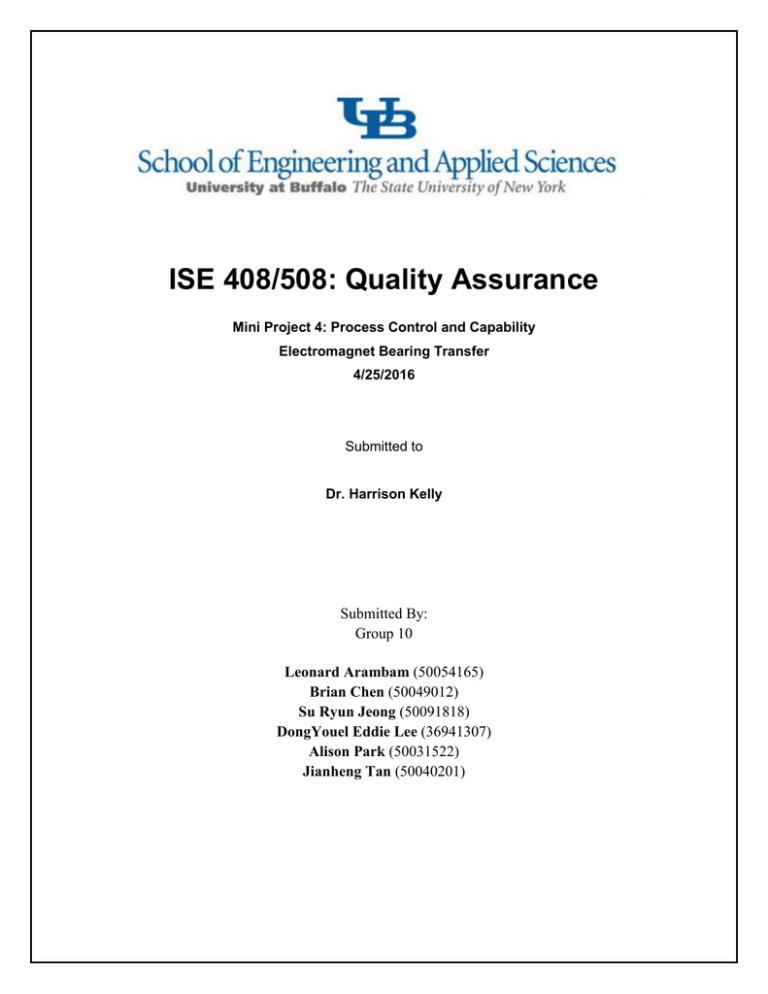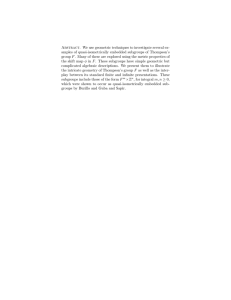IE408MiniProject4.docx
advertisement

ISE 408/508: Quality Assurance Mini Project 4: Process Control and Capability Electromagnet Bearing Transfer 4/25/2016 Submitted to Dr. Harrison Kelly Submitted By: Group 10 Leonard Arambam (50054165) Brian Chen (50049012) Su Ryun Jeong (50091818) DongYouel Eddie Lee (36941307) Alison Park (50031522) Jianheng Tan (50040201) Table of Contents Introduction 2 Methodologies 3 Analysis 4 Results 11 Conclusions 12 1 Introduction A company is asking an industrial engineer to see if the electromagnet process of picking up ball bearings and transferring them from one container to another. This process has been optimized previously; now it will be seen if the process is controlled. In Mini Project 3, the optimal set-up is determined for picking up the maximum amount of ball bearings via an electromagnet. In this project, we will determine whether or not the process is stable, if the process is in a state of control, and the process can meet the requirements. This is done by analyzing Xbar and R charts, analyzing Normal Probability plots, and Process capability reports. To increase of the results generated, the team will collect 25 average sample data of size 5 and analyze the data to see if the process is in control, if the process is not in control then we will collect 10 more sample points and calculate a control limit to meet the specifications of the customer. 2 Methodology Using the same materials as Mini Project 3, the electromagnet is assembled in the optimal set-up as to pick up as many ball bearings as possible. The optimal set-up is a thin core, long wire, 3 batteries, two passes, six seconds, and corner. Two shot containers were set up so that ball bearings could be transferred from one to another. Then, five subgroups of data were taken, with five trials in each subgroup. This results in 25 total data points. Five minutes passes before starting the experiment again, and another five subgroups of five trials were created. This is repeated until there are a total of 25 subgroups. From mini project 3, DOE offers an optimized design and statistical evidence for the process in order to know whether or not the process is in-control by the means of statistical process control. The purpose of a SPC is monitoring, controlling, and improving a process over a period of time. For this project, the statistical process control is used to monitor the process of retrieving ball bearings and to determine whether or not new trial control limits need to be established. The eventual goal of SPC is reduction or elimination of variability in the process by identification of assignable causes. SPC is approximately equivalent to repeated hypothesis tests comparing the short-term variability to long term variability. Then, the data is analyzed via Minitab. The trial control limits are determined and interpreted then additional control limits are chosen for usage on the next set of trials. Then, 10 more subgroups of five trials each are taken and analyzed. The process capability will be determined, and then the process performance will be estimated. The purpose of the process capability report is to show whether or not the data collected meets the requirements. It also is to compare the process specification to the process output and determine statistically if the process can meet specifications. The less variation present in the process, the more capability the data will be to meet specifications. The report also represents the overall and potential capability of the data. 3 Analysis The initial 25 subgroups with 125 data points (Trial1) has an Xbar-R chart shown below: Figure 1. Xbar- R Chart of Trial 1 As shown in Figure 1. the R-bar chart, all points are randomly distributed around the central line and within the control limit. Therefore, process variation for this data set is in control. Also, from X-bar chart, all points are randomly distributed around the central line and within the control limit. This indicates that the electromagnet is stable and under control for the whole experiment. 4 Figure 2. Probability Plot of Trial 1 As shown in Figure 2. probability plot, the average for trial 1 is 10.25 and the standard deviation is 3.573. Data points follow the straight line with P-value greater than 0.05. Therefore, the normal distribution is a good fit for sample set. Figure 3. Process Capability Report for Trial 1 As shown Figure 3. Lower Specific Control Limit set to 5 and Trial 1 process was not within the specification limits. Cpk is 0.49 which is less than 1, therefore; some of the data points did not meet specification. Therefore, this process is incapable of producing output that meets LSL of 5 requirements even if it’s in statistical control. 5 Figure 4. Process Capability Sixpack Report for Trial 1 From Figure 4, we can see that The Xbar Chart and R chart have no out of control points for each subgroup, and therefore do not need any tweaking in the process. The Last 25 subgroups is also displayed, which show the total 125 points displayed among the 25 subgroups. The Capability Histogram shows the data set, as well as the LSL, which is 5. This indicates that the Process is incapable of satisfying the LSL, because there are data points below the LSL. The Normal Probability Plot is also shown, which has a P-value of .067, which is greater than .05, which indicates that the data fits a normal distribution. 6 The new 50 data points and 10 new subgroups of size 5 (Trial2) has an Xbar-R chart shown below: Figure 5. Xbar-R Chart of Trial 2 As shown in Figure 5. the R-bar chart, all points are randomly distributed within the control limit. Therefore, process variation for this data set is in control. Also, from X-bar chart, all points are randomly distributed around the central line and within the control limit. This indicates that the electromagnet is stable and under control for the whole experiment. 7 Figure 6. Probability Plot of Trial 2 In Figure 6, the P-value for the probability plot of Trial 2 is less than 0.05, which indicates that the data does not fit to a normal distribution. For this, a Box-Cox transformation is necessary. Figure 7. Box-Cox Plot of Trial 2 In Figure 7, the Box-Cox Plot of Trial 2 is displayed. This shows the normalization of our data set. From Box-Cox plot, Lambda is determined as 0.50 and this Lambda will be used to transform the data in process capability. 8 Figure 8. Process Capability Report for Trial 2 Figure 8 shows transformed data with Lambda 0.5 and it indicates that the process is incapable of meeting the requirements which LSL of 5. The Cpk Value of 0.48 is below 1, and therefore some of the requirements will not be met. 9 Figure 9. Process Capability Sixpack Report for Trial 2 Figure 9 first has the Xbar Chart as well as the R chart, both which indicate that there are no out of control points of subgroups, as well as show the entire 125 data points within the 25 subgroups. The Capability histogram indicates that there are points below the LSL, and therefore the process is incapable of meeting the requirements. The Normal Probability plot ha a P-value of 0.01, which is below 0.05, and therefore the data set does not fit the normal distribution. 10 Results In Figure 1, the Xbar-R chart of trial 1 shows that there are no out of control points for the average of subgroups, which indicates that no trial control limits need to be introduced to the process. In Figure 2 the Probability Plot of Trial 1 has a P-value of .067, which is above .05. This indicates that the data is a good fit to the normal distribution. The Cpk for Trial 1 is .49, which is below 1. This indicates that some output of the process will not meet requirements. The Process Capability Sixpack report for trial 1 also shows the .067 P-value for the normal probability plot. According to this data, there were no out of control data points of the average of subgroups, and is within the normal probability plot, and therefore there was no need to change the process control limits from trial 1 to trial 2. In Figure 5, the Xbar-R chart of trial 2 shows that there are no out of control points for the average of subgroups, which indicates that there is no change needed in the process. In Figure 6, the P-value is <.005, which indicates that the data does not fit the normal distribution. In figure 8, the Box-Cox chart is used to normalize the data set with a lambda value of .5. In figure 7, the Cpk for Trial 2 is .48, which also indicates that some of the output processes will not meet requirements. In figure 9, Trial 2 has a P-value of .01 for the Normal Probability Plot, and therefore it is not above .05, and does not represent a normal distribution.This is most likely due to the battery losing power as the experiment went on, giving inconsistent and biased data. 11 Conclusion Based on our data, the consistently low Cpk values indicate that the process is incapable of meeting the requirements set which posed as a problem during the experiment. A method to control Cpk values is to increase the sample size of data collected, and therefore increasing the Cpk. The process is also incapable of meeting the requirements set based on the histogram of capability, in which there are data points below the LSL. The data does not have any points on the Xbar and R charts that are out of control, so therefore the process trial control limits do not need to be altered. The Normality probability chart of Trial 1 indicates that it fits a normal distribution, but the normality probability chart of trial 2 indicates that the second data set does not fit a normal distribution, therefore highlighting possible inconsistencies in the data. This could be due to the fact that the batteries have been not used for over a month, and could have different voltages, resulting in inconsistent. Therefore, the Process is Stable and in a state of control, but is not capable of meeting the process requirements. This is shown in the Xbar and R charts, the Normal probability plot, and the Process capability reports. 12

